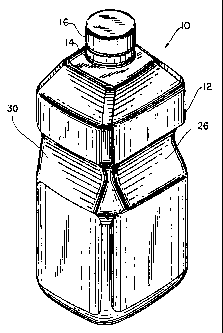Some of the information on this Web page has been provided by external sources. The Government of Canada is not responsible for the accuracy, reliability or currency of the information supplied by external sources. Users wishing to rely upon this information should consult directly with the source of the information. Content provided by external sources is not subject to official languages, privacy and accessibility requirements.
Any discrepancies in the text and image of the Claims and Abstract are due to differing posting times. Text of the Claims and Abstract are posted:
| (12) Patent: | (11) CA 2107072 |
|---|---|
| (54) English Title: | BEVERAGE BOTTLE |
| (54) French Title: | BOUTEILLE POUR BOISSON |
| Status: | Expired and beyond the Period of Reversal |
| (51) International Patent Classification (IPC): |
|
|---|---|
| (72) Inventors : |
|
| (73) Owners : |
|
| (71) Applicants : |
|
| (74) Agent: | DEETH WILLIAMS WALL LLP |
| (74) Associate agent: | |
| (45) Issued: | 2004-11-23 |
| (22) Filed Date: | 1993-09-27 |
| (41) Open to Public Inspection: | 1995-03-28 |
| Examination requested: | 1999-09-23 |
| Availability of licence: | N/A |
| Dedicated to the Public: | N/A |
| (25) Language of filing: | English |
| Patent Cooperation Treaty (PCT): | No |
|---|
| (30) Application Priority Data: | None |
|---|
A plastic bottle for beverages includes a body made of
several straight or planar sidewalls, some of which are provided
with arcuate grooves forming a finger grip. The bottle is also
provided with a closure threadedly mounted so that it can be
removed at will for dispensing a beverage. The container can be
easily held during beverage dispensal by the finger grips.
Note: Claims are shown in the official language in which they were submitted.
Note: Descriptions are shown in the official language in which they were submitted.

2024-08-01:As part of the Next Generation Patents (NGP) transition, the Canadian Patents Database (CPD) now contains a more detailed Event History, which replicates the Event Log of our new back-office solution.
Please note that "Inactive:" events refers to events no longer in use in our new back-office solution.
For a clearer understanding of the status of the application/patent presented on this page, the site Disclaimer , as well as the definitions for Patent , Event History , Maintenance Fee and Payment History should be consulted.
| Description | Date |
|---|---|
| Time Limit for Reversal Expired | 2010-09-27 |
| Letter Sent | 2009-09-28 |
| Inactive: IPC from MCD | 2006-03-11 |
| Inactive: Office letter | 2005-05-18 |
| Grant by Issuance | 2004-11-23 |
| Inactive: Cover page published | 2004-11-22 |
| Pre-grant | 2004-08-19 |
| Inactive: Final fee received | 2004-08-19 |
| Notice of Allowance is Issued | 2004-07-08 |
| Letter Sent | 2004-07-08 |
| Notice of Allowance is Issued | 2004-07-08 |
| Inactive: Approved for allowance (AFA) | 2004-06-30 |
| Amendment Received - Voluntary Amendment | 2004-03-22 |
| Inactive: S.30(2) Rules - Examiner requisition | 2004-01-20 |
| Amendment Received - Voluntary Amendment | 2003-10-30 |
| Inactive: S.30(2) Rules - Examiner requisition | 2003-09-16 |
| Amendment Received - Voluntary Amendment | 2003-05-30 |
| Inactive: S.30(2) Rules - Examiner requisition | 2002-12-17 |
| Appointment of Agent Requirements Determined Compliant | 2001-06-12 |
| Inactive: Office letter | 2001-06-12 |
| Inactive: Office letter | 2001-06-12 |
| Revocation of Agent Requirements Determined Compliant | 2001-06-12 |
| Appointment of Agent Request | 2001-04-19 |
| Revocation of Agent Request | 2001-04-19 |
| Amendment Received - Voluntary Amendment | 2000-08-15 |
| Inactive: Status info is complete as of Log entry date | 1999-10-05 |
| Letter Sent | 1999-10-05 |
| Inactive: Application prosecuted on TS as of Log entry date | 1999-10-05 |
| All Requirements for Examination Determined Compliant | 1999-09-23 |
| Request for Examination Requirements Determined Compliant | 1999-09-23 |
| Application Published (Open to Public Inspection) | 1995-03-28 |
There is no abandonment history.
The last payment was received on 2004-08-30
Note : If the full payment has not been received on or before the date indicated, a further fee may be required which may be one of the following
Please refer to the CIPO Patent Fees web page to see all current fee amounts.
| Fee Type | Anniversary Year | Due Date | Paid Date |
|---|---|---|---|
| MF (application, 4th anniv.) - standard | 04 | 1997-09-29 | 1997-09-25 |
| MF (application, 5th anniv.) - standard | 05 | 1998-09-28 | 1998-09-21 |
| MF (application, 6th anniv.) - standard | 06 | 1999-09-27 | 1999-09-20 |
| Request for examination - standard | 1999-09-23 | ||
| MF (application, 7th anniv.) - standard | 07 | 2000-09-27 | 2000-09-21 |
| MF (application, 8th anniv.) - standard | 08 | 2001-09-27 | 2001-09-07 |
| MF (application, 9th anniv.) - standard | 09 | 2002-09-27 | 2002-07-18 |
| MF (application, 10th anniv.) - standard | 10 | 2003-09-29 | 2003-07-14 |
| Final fee - standard | 2004-08-19 | ||
| MF (application, 11th anniv.) - standard | 11 | 2004-09-27 | 2004-08-30 |
| MF (patent, 12th anniv.) - standard | 2005-09-27 | 2005-09-01 | |
| MF (patent, 13th anniv.) - standard | 2006-09-27 | 2006-08-30 | |
| MF (patent, 14th anniv.) - standard | 2007-09-27 | 2007-08-31 | |
| MF (patent, 15th anniv.) - standard | 2008-09-29 | 2008-08-29 |
Note: Records showing the ownership history in alphabetical order.
| Current Owners on Record |
|---|
| TROPICANA PRODUCTS, INC. |
| Past Owners on Record |
|---|
| GRISCOM III BETTLE |
| JO LEE BROOKS POTTS |
| JOANN H. MILLER |
| MARVIN W. HODGE |